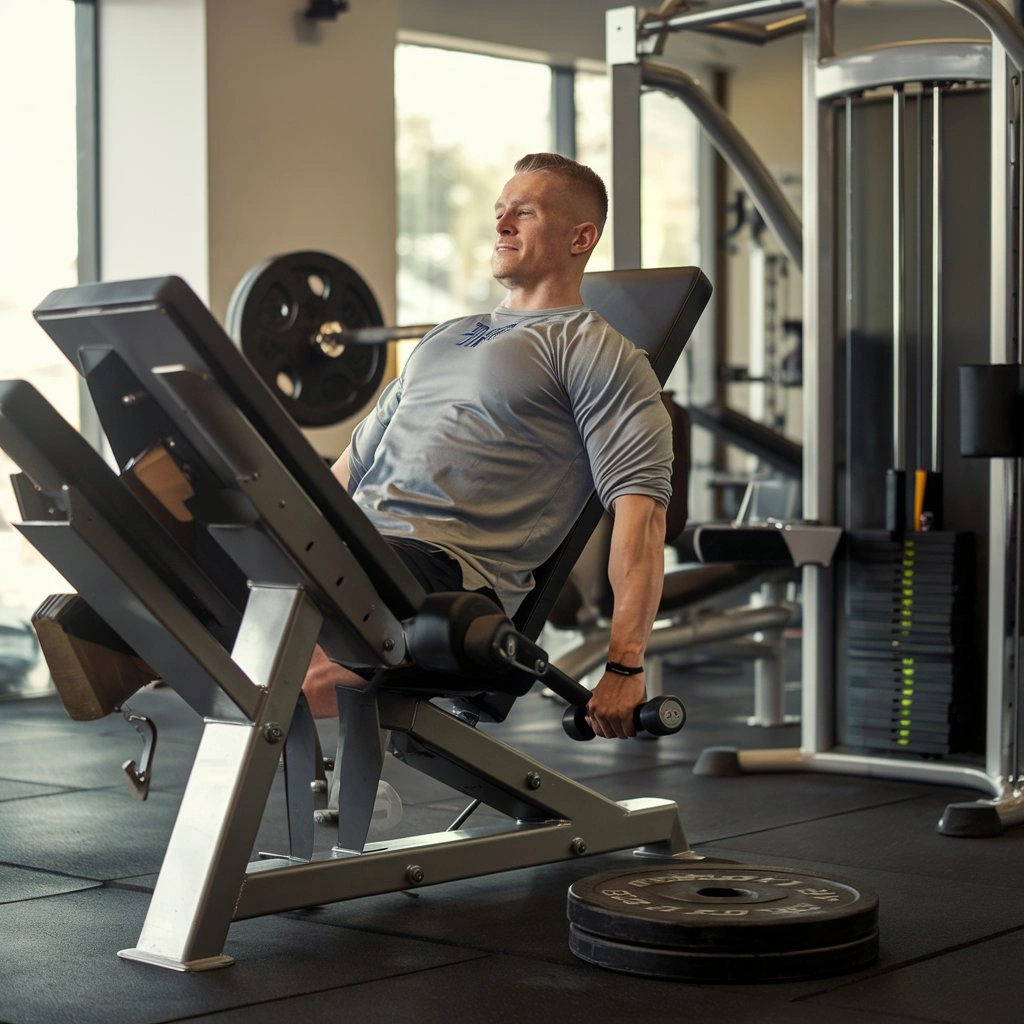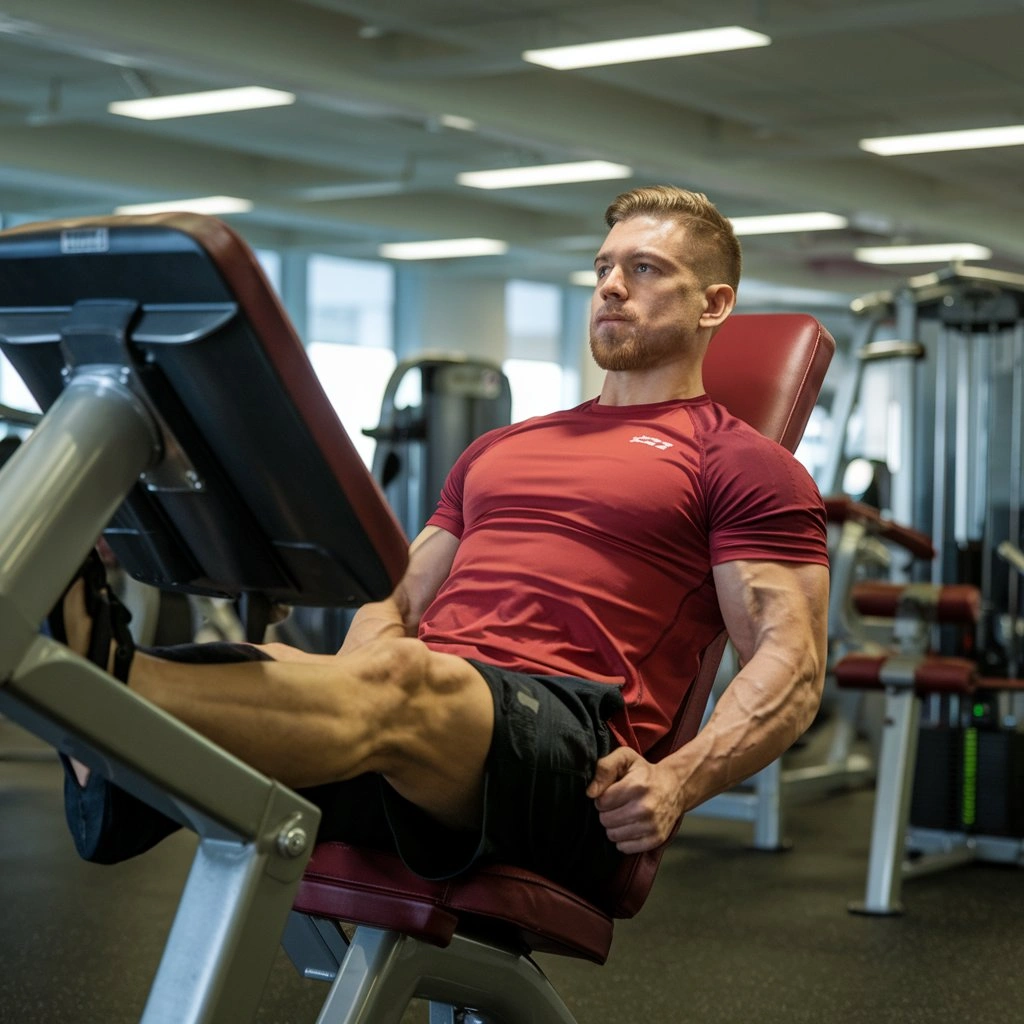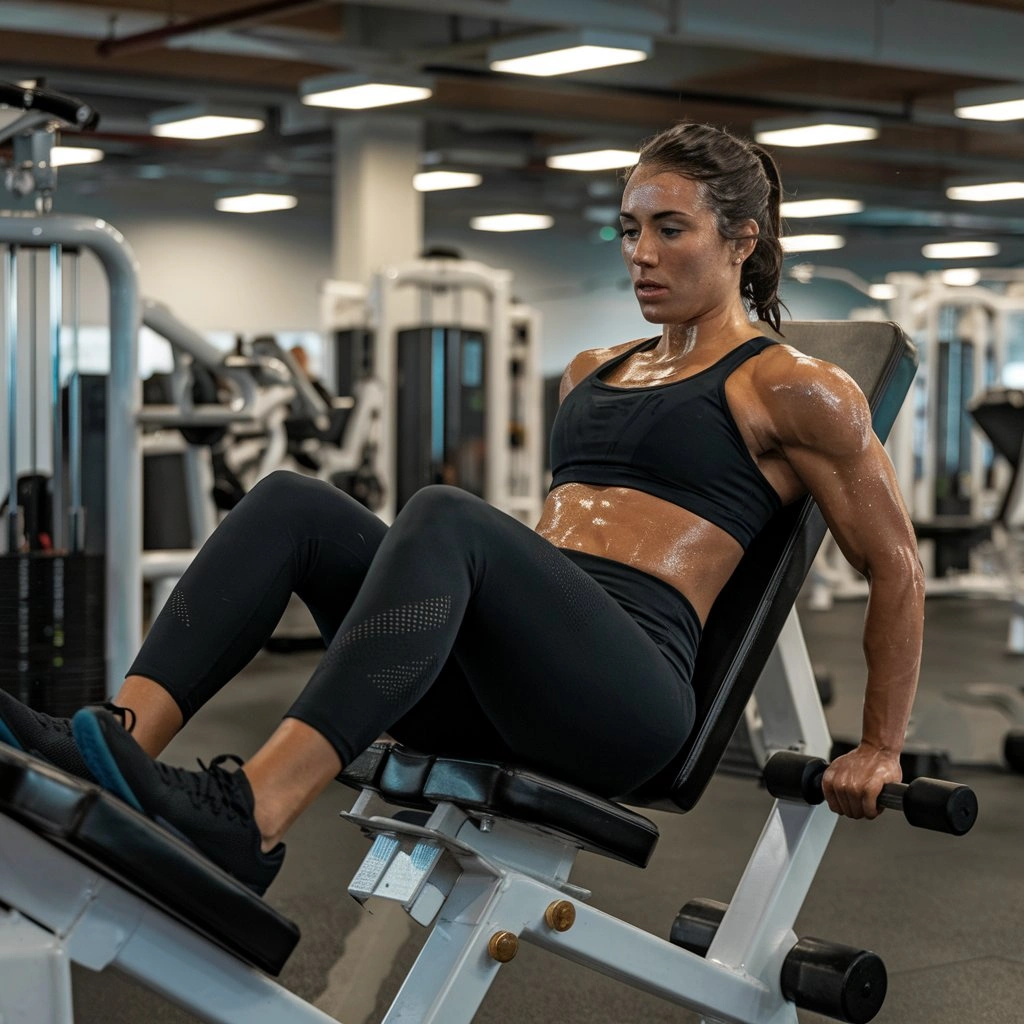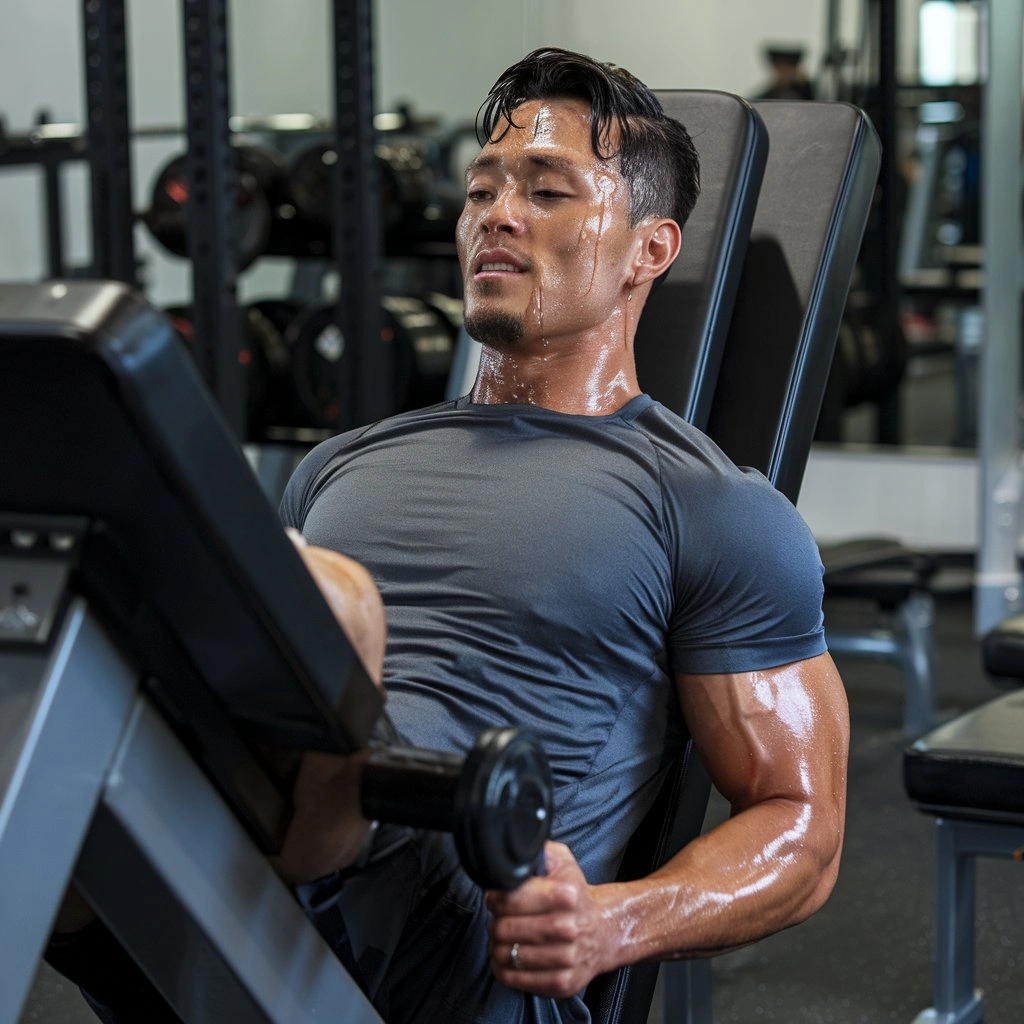Ever wondered about those cool gym machines where you sit down and push away with your legs? That’s the leg press machine. And there’s a special kind that lets you train your legs at an angle – the incline leg press machine. This article will be your guide to this awesome piece of equipment!
What is it and Why Use It?
The incline leg press machine looks a bit like a comfy chair with a platform for your feet. But instead of relaxing, you get to challenge your legs by pushing the platform away. Here’s the cool part: tilt the seat back, so you can push at an angle. This makes the exercise a little different from a regular leg press.
Why would you want to use an incline Leg Press Machine? It’s a great way to strengthen your Leg Muscles. It’s great for your quads. Those are the muscles in the front of your thighs. It’s also great for your glutes. Those are your butt muscles. By changing how you position your feet on the platform. You can target these muscles in different ways.
A Short Journey Through Time: How the Incline Leg Press Became a Gym Favorite
Believe it or not, Leg Press Machines have been around for a long time! Early versions showed up in gyms in the 1950s. Back then, they were pretty basic. But, they offered a safer alternative to squats with weights. Those can be tricky to learn.
The Incline Leg Press Machine came along a bit later, probably in the 1970s or ’80s. People tried different exercise machines. Designers found that tilting the seat could create a new exercise. It targeted the legs in a slightly different way.
Anatomy and Mechanics
The Building Blocks of an Incline Leg Press
The leg press machine might look simple. But, it’s made of several key parts. They work together to give a safe and effective workout. Here’s a breakdown of the anatomy of an incline leg press machine:
- Seat and Backrest: The comfy chair-like part you sit on. The backrest is usually angled backward, anywhere from 45 to 75 degrees. This is what makes it an “incline” leg press.
- Foot Platform: The platform where you place your feet. It may have a rough surface to prevent slipping. It can fit various foot placements.
- Weight Stack or Plate Holders: Here you add weight plates to make the exercise harder. Machines with weight stacks use selector pins to easily add or remove weight. Plate-loaded machines require you to manually add or remove Weight Plates.
- It holds the weight plates or weight stack. It slides up and down on vertical rails. As you push the foot platform, you push against the weight carriage.
- Push Handles: These are grips on the sides of the seat that you can hold onto for stability during the exercise.
 How Your Body Moves on the Incline Leg Press
How Your Body Moves on the Incline Leg Press
When you use the incline leg press machine, you’re doing a compound exercise. This means it works many muscles at once. Here’s a breakdown of the biomechanics involved:
- Starting Position: Sit on the machine with your back firmly against the backrest. Place your feet flat on the foot platform, shoulder-width apart. Your toes should be pointing slightly outward. Unhook the safety catches (if present) on the weight carriage so you can press the weight.
- Lower the weight slowly: Do this by pushing the foot platform away from you. As you lower the weight, feel your quads and glutes lengthen. It’s important to control the weight during this phase of the movement.
- Lifting the Weight: Once you reach the bottom (where your knees are at a 90-degree angle), push the weight back to the start. Do this by pressing your feet into the foot platform. Focus on using your quads and glutes to generate the force to lift the weight.
- At the top, your legs should be almost straight, but not locked. Squeeze your glutes at the top to contract the muscle fully.
Targeting Key Muscles with the Incline Leg Press
The incline leg press machine is a great way to target several major muscle groups in your lower body. Here’s a breakdown of the primary muscles worked during this exercise:
- Quadriceps (Quads): These are the muscles in the front of your thighs. They are the primary movers in the incline leg press exercise.
- Glutes (Gluteus Maximus and Gluteus Medius): These are your butt muscles. They help to extend your hips and stabilize your body during the movement.
- Hamstrings: The muscles on the backside of your thighs. They are not the main movers. But, they help to stabilize the knee joint during the incline leg press.
- Calves: The muscles in your lower legs. They are used to push down on the foot platform during the exercise.
By moving your foot on the platform, you can emphasize certain muscles more. Here’s a quick guide:
- Put your feet shoulder-width apart. This targets your quads, glutes, and hamstrings equally.
- Place your feet wide (wider than shoulder-width apart). This emphasizes the inner thighs (adductor muscles) and glutes.
- Place your feet closer together than shoulder-width apart. This position emphasizes the outer thighs (quads) and hamstrings.
Benefits of Using the Incline Leg Press Machine
The leg press isn’t just another gym machine. It’s a powerhouse for building lower body strength and definition. Let’s explore some of the key benefits. They make this machine a favorite among fitness fans.
Building a Strong Foundation: Strengthening Key Lower Body Muscles
The incline leg press has a big advantage. It can target many muscles in your lower body. Here’s how it strengthens these key muscles:
- Quadriceps (Quads): These are the muscles that give your thighs their shape and power. The incline leg press works them hard during the push. It helps you build strong, sculpted quads.
- Glutes (Gluteus Maximus and Gluteus Medius) are key. They are vital for lower body strength, core stability, and posture. The incline leg press helps activate and strengthen your glutes. This leads to a firmer, rounder backside.
- Hamstrings are not the main movers. They are on the back of your thighs. They also get engaged during the incline leg press. This helps maintain balance in your legs and prevents muscle imbalances.
- Your calves are crucial. They push off the ground when walking, running, and jumping. The incline leg press uses your calves to press the platform. This gives them a good workout and builds lower leg strength.
Add the incline leg press to your routine. It will build a strong and balanced lower body. This is crucial for athletics and daily life.
 Safety First: A Controlled Environment for Leg Strength Training
Safety First: A Controlled Environment for Leg Strength Training
It offers more control for leg strength training. Free-weight exercises like squats can be compared to this. Here’s how it enhances safety:
- They reduce the risk of injury. Free weights must have proper form and balance to use them safely. The incline leg press machine stabilizes your upper body. It lets you focus on pushing with your legs. You don’t have to worry about losing balance or dropping weights. This is especially beneficial for beginners or those recovering from injuries.
- You can adjust the weight. You do this by using weight stacks or selector pins. This controlled progression helps you avoid overloading your muscles. It also lowers the risk of injuries.
- The incline leg press design encourages a full range of motion for your knees. This ensures that you target all parts of your quads and hamstrings well.
You can use the incline leg press to train your legs with confidence. You’ll be in a safe and controlled place that minimizes the risk of injuries.
Personalized Power: Targeting Specific Leg Areas
One of the cool things about the incline leg press is its versatility. You can adjust your foot placement on the platform and the backrest angle. This allows you to target specific areas of your lower body. Here’s how it works:
- Standard Placement is the most common foot position. It works your quads, glutes, and hamstrings equally. It’s a great all-around option for building overall lower body strength.
- A wide stance is wider than shoulder-width apart. It puts more emphasis on your inner thighs (adductor muscles) and glutes. This is a good option if you want to sculpt and tone your inner thighs.
- Stand with your feet closer than shoulder-width apart. This targets your outer thighs (quads) and hamstrings more. This can be helpful if you want to define and strengthen the outer part of your quads.
Additionally, some incline leg press machines allow you to adjust the backrest angle. A steeper incline (about 75 degrees) works your glutes. A shallower incline (about 45 degrees) targets your quads.
You can experiment with different foot placements and backrest angles. This lets you tailor your leg press workouts. You can target specific muscles and get your desired results.
Proper Technique and Form
The incline leg press machine is a great tool for building lower body strength. But, you need proper form to get the best results and avoid injury. Here’s a breakdown of proper technique and form to ensure you get the most out of this exercise:
Setting the Stage: Correct Body Positioning and Alignment
Before you start pushing weight, it’s important to position yourself well. Do so on the incline leg press machine. Here’s what to focus on:
- Seating: Sit comfortably on the seat. Press your back against the backrest. Adjust the backrest angle to your preference. Keep it between 45 and 75 degrees.
- Foot Placement: Place your feet flat on the foot platform, shoulder-width apart. Your toes should point slightly outward. They should follow the angle of your legs. Try different foot placements (wide, narrow, standard). They target specific muscle groups, as discussed earlier.
- Grip it Tight: Hold onto the side handles for stability throughout the exercise. This helps you keep a good upper body posture. It stops you from arching your back.
Controlled Power: Importance of Controlled Movements and Full Range of Motion
Once you’re positioned correctly. Now, focus on controlled movements and full motion. Here’s how to ensure optimal results:
- Controlled Descent: Lower the weight carriage slowly. Do this by pushing the foot platform away from you. Breathe in as you lower the weight. Focus on feeling your quads and glutes lengthening during this phase. Don’t let the weight drop quickly – control the descent throughout the entire movement.
- Full Range of Motion: Lower the weight until your knees are bent at a 90-degree angle. But, don’t fully collapse them. You should still feel some tension in your quads at the bottom of the movement.
- Once you’ve reached the bottom, exhale and push the weight back up. Press your feet firmly into the platform. Focus on using your quads and glutes to generate the force, not your back or hips.
- At the top of the movement, extend your legs almost straight. But, don’t lock your knees. Locking your knees can put unnecessary stress on your joints. Squeeze your glutes at the top to achieve a full muscle contraction.
- Focus on controlled movements. Achieving a full range of motion will engage muscles and get the most out of each rep.
Safety First: Precautions and Common Mistakes to Avoid
The incline leg press machine offers a safe place for leg training. But, it’s still important to rank safety. Here are some common mistakes to avoid and safety precautions to remember:
- Ego Lifting: Don’t overload the weight stack! Start with a lightweight. You can control it easily. Increase it slowly as you get stronger. Using lighter weights with good form is better. It’s also safer than using heavy weights with bad form.
- Keep your back flat against the backrest. Do this the whole time. Avoid arching your back as you push the weight – this can put strain on your spine.
- Bouncing at the Bottom: Don’t bounce at the bottom of the movement to gain momentum. This can take tension off your muscles and increase the risk of injury.
- Holding Your Breath: Breathe normally throughout the exercise. Inhale as you lower the weight and exhale as you push it back up. Holding your breath can restrict blood flow and increase blood pressure.
- Ego on Plates (Plate-Loaded Machines): If you’re using a plate-loaded machine, don’t use too much weight. Ask for help from a spotter if needed.
 Variations and Advanced Techniques
Variations and Advanced Techniques
The incline leg press machine is a versatile tool, but who wants a boring workout? Here are some changes and advanced moves. They will keep your routine interesting and challenge your muscles in new ways.
Footwork Finesse: Targeting Specific Muscles with Foot Placement and Angles
We already discussed how standard, wide, and narrow foot placements target different muscles. They work on those in your lower body. Let’s explore some more variations:
- For a quad-focused workout, try placing your toes higher up on the footpad. Keep your heels on the bottom edge. This increases the quadriceps activation during the pushing motion.
- Heel Press: Want to target your glutes more? Place your heels higher up on the footpad, with your toes pointed down. This shifts the emphasis to your glutes as you push the weight.
- This variation of the leg press is advanced. It challenges your balance and core stability. It works on each leg. Do the incline leg press with one leg at a time. Focus on keeping the proper form as you move.
By trying different foot placements and variations, you can create a personalized workout. It will target specific muscles in your lower body.
Unilateral Power: Balance and Symmetry with Single-Leg Presses
The standard incline leg press works both legs. While this is effective, incorporating unilateral (single-leg) exercises can offer some more benefits:
- Single-leg exercises challenge your core. They improve your ability to balance on one leg. This leads to better stability in daily activities.
- Identifying and Addressing Weaknesses: Unilateral exercises can help you find strength imbalances. These are imbalances between your right and left leg. You can then focus on strengthening the weaker side for a more symmetrical physique.
- Single-leg exercises need more core activation to keep proper form. They give your core an extra workout along with your legs.
If you’re comfortable with the standard leg press, give single-leg presses a try! They can add a new challenge to your workout and improve your balance and core strength.
Kicking Up the Intensity: Adding Resistance Bands or Weights
Once you’ve mastered the basic techniques and variations, you can make your incline leg press harder by adding weight.
- Resistance Bands: Loop a resistance band around the top of the weight carriage and the bottom frame of the machine. This adds extra resistance throughout the entire range of motion.
- Ankle Weights: Strap ankle weights around your ankles for additional resistance during the exercise. This is a good way to gradually increase the difficulty as you get stronger.
- Weight Plates (Plate-Loaded Machines Only): If you’re using a plate-loaded incline leg press, you can progressively overload the weight by adding more weight plates. However, prioritize proper form over ego-lifting heavy weights.
Training Programs and Considerations
The incline leg press machine can be a valuable tool for people of all fitness levels. Here’s a guide to incorporating it into your workout routine, including sample programs, training considerations, and how to integrate it with other exercises for a well-rounded leg workout:
Stepping Up Your Game: Sample Workouts for Different Levels
Here are some sample workout routines using the incline leg press machine, tailored for beginners, intermediate, and advanced exercisers:
- Beginner
- 2-3 sets of 10-12 repetitions
- Start with a weight that allows you to maintain proper form throughout the entire movement.
- Focus on controlled movements and a full range of motion.
- Rest for 30-60 seconds between sets.
- Intermediate
- 3-4 sets of 8-10 repetitions
- Increase the weight to challenge yourself, but don’t compromise on form.
- Try different foot placements (standard, wide, narrow) to target different muscle groups.
- Rest for 60-90 seconds between sets.
- Advanced
- 4-5 sets of 6-8 repetitions
- Push yourself with heavier weights while maintaining perfect form.
- Incorporate advanced techniques like single-leg presses or adding resistance bands.
- Rest for 90-120 seconds between sets.
These are just examples, and you may need to adjust them based on your individual fitness level and goals. It’s always a good idea to consult with a certified personal trainer for personalized guidance.
The Secret Sauce: Frequency, Sets, Reps, and Rest Periods
To achieve optimal results with the incline leg press, consider these training variables:
- Frequency: Aim to train your legs 2-3 times per week, allowing enough rest for recovery between workouts.
- Sets and Reps: For beginners, 2-3 sets of 10-12 repetitions are a good starting point. As you get stronger, you can gradually increase the weight, decrease the repetitions (8-10 reps), and perform more sets (3-4 sets). Advanced users can further decrease reps (6-8) and increase sets (4-5).
- Rest Periods: Rest periods are crucial for muscle recovery. Beginners can rest for 30-60 seconds, while intermediate and advanced exercisers can rest for 60-120 seconds between sets.
Listen to your body and adjust these variables as needed. It’s better to use lighter weights with proper form than to go too heavy and risk injury.
Building a Strong Foundation: Integrating the Incline Leg Press with Other Exercises
The incline leg press machine is a great exercise, but it shouldn’t be the only one in your leg workout routine. Here’s how to integrate it with other exercises for a well-rounded leg training program:
- Compound Exercises: Include compound exercises like squats, lunges, and deadlifts (with proper form) to target multiple muscle groups in your legs simultaneously.
- Isolation Exercises: Incorporate isolation exercises like hamstring curls and calf raises to target specific muscle groups for additional sculpting and definition.
- Cardio: Don’t forget cardio exercises like running, biking, or swimming! These activities improve overall cardiovascular health and can help with leg conditioning.
 Precautions and Contraindications
Precautions and Contraindications
The incline leg press machine is a fantastic tool for building leg strength, but like any exercise, it’s important to prioritize safety. Here’s a breakdown of potential risks, individuals who should be cautious, and why consulting a professional is crucial before diving in:
Avert the Risks: Improper Use and Overloading
While the incline leg press offers a controlled environment, improper use or overloading can lead to injuries. Here’s what to watch out for:
- Improper Form: Using improper form, like arching your back or bouncing at the bottom of the movement, puts unnecessary strain on your spine and joints.
- Ego Lifting: Don’t be tempted to use weights that are too heavy! Focus on controlled movements and proper form rather than lifting the most weight possible.
- Sudden Increases in Weight: Gradually increase the weight as you get stronger. Trying to jump to a much heavier weight can increase your risk of injury.
- Neglecting Warm-Up and Cool-Down: Always warm up your muscles with light cardio and dynamic stretches before your workout. Cool down with static stretches afterward to improve flexibility and prevent muscle soreness.
By following proper form, using appropriate weight, and listening to your body, you can minimize the risk of injuries while enjoying the benefits of the incline leg press.
Caution First: Individuals with Pre-Existing Conditions or Injuries
While the incline leg press is a great exercise for many, some individuals should be cautious or avoid it altogether. Here are some situations to consider:
- Knee Injuries: If you have any pre-existing knee injuries, consult with a doctor or physical therapist before using the incline leg press. They can advise you on proper form and weight limitations to avoid aggravating the injury.
- Back Problems: Individuals with lower back problems should be cautious with the incline leg press, especially if they have trouble maintaining proper form. Consider consulting a professional for alternative exercises that target your legs without putting strain on your back.
- High Blood Pressure: If you have high blood pressure, it’s important to talk to your doctor before starting any new exercise program, including the incline leg press.
Remember, it’s always better to be safe than sorry. If you have any concerns, consult with a healthcare professional before using the incline leg press machine.
Knowledge is Power: Consulting a Professional for Guidance
No matter your fitness level, consulting with a certified personal trainer or healthcare provider before starting a new exercise program, including the incline leg press, is highly recommended. Here’s why:
- Personalized Guidance: A professional can assess your fitness level, identify any limitations, and create a personalized workout program that incorporates the incline leg press safely and effectively.
- Proper Form Technique: They can teach you proper form and technique to ensure you’re getting the most out of the exercise while minimizing the risk of injury.
- Gradual Progression: A professional can help you set realistic goals and gradually increase the difficulty of your incline leg press workouts to promote safe and sustainable progress.
Conclusion
The incline leg press machine isn’t just another piece of gym equipment; it’s a powerhouse for building lower body strength and definition. It offers a controlled environment for leg training, making it suitable for beginners and seasoned gym-goers alike.
This versatile machine allows you to target various muscle groups in your lower body by adjusting foot placement and backrest angle. Whether you want to focus on your quads, glutes, or hamstrings, the incline leg press can be customized to meet your needs.
However, to truly unlock the benefits of the incline leg press and avoid injuries, prioritizing safety and proper technique is paramount. Remember, proper form is crucial for maximizing muscle engagement and minimizing strain on your joints. Don’t be afraid to start with lighter weights and gradually increase the difficulty as you get stronger.
Consulting with a certified personal trainer or healthcare professional can be incredibly beneficial. They can assess your fitness level, teach you proper form, and create a personalized program that incorporates the incline leg press safely and effectively into your overall workout routine.
So, the next time you hit the gym, consider incorporating the incline leg press into your routine. With proper guidance, this versatile machine can become a valuable tool on your journey towards building strong, sculpted, and healthy legs. Remember, consistency is key! Stick to your program, prioritize safety, and watch your lower body strength and definition flourish!

